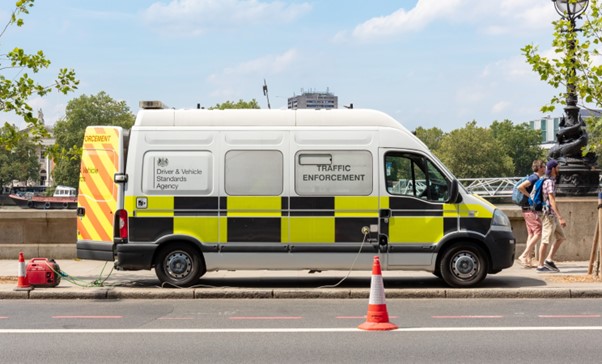
Susie Jones
Explicação dos controlos DVSA para veículos pesados de mercadorias
Criado: 08/08/2024
•
Atualizado: 08/08/2024
Durante a sua carreira de camionista, poderá ser mandado parar pela Agência de Normas de Condutores e Veículos (DVSA). Para os condutores de camiões novos na indústria, este pode ser um processo assustador. No entanto, compreender os aspectos essenciais dos controlos de camiões da DVSA pode tornar o processo menos stressante.
Quem é a DVSA?
De acordo com [Gov.uk] (http://gov.uk/), a DVSA é responsável por "efetuar controlos na estrada a condutores e veículos comerciais para se certificar de que cumprem as regras de segurança e mantêm o seu veículo seguro para conduzir".
A DVSA pode efetuar inspecções pontuais ao seu camião e emitir proibições. As proibições impedem um condutor de camião de conduzir até que o problema com o seu veículo seja resolvido.
A polícia também tem autoridade para mandar parar um camionista e efetuar controlos semelhantes.
Qual é o aspeto dos examinadores da DVSA?
Existem algumas formas de identificar um examinador da DVSA. Vestem coletes de visibilidade amarelos com o logótipo DVSA e têm sempre um cartão de autorização. Os seus veículos têm uma estampa preta e amarela com o logótipo da DVSA no capot.

O que acontece se for mandado parar?
Não parar quando solicitado por um examinador da DVSA é uma infração. Se um examinador pedir para encostar, ele fará a verificação na berma da estrada ou num local de testes dedicado. O principal objetivo destas paragens é manter os veículos inseguros fora da estrada.
O examinador efectuará as seguintes verificações obrigatórias:
Verificação do peso da carga autorizada e do tipo de carga
Verificação de defeitos mecânicos e controlo técnico
Garantir que os registos do tacógrafo estão correctos
Certifique-se de que possui uma carta de condução válida.
Quanto tempo demora uma inspeção DVSA?
Em média, uma inspeção DVSA demora 15 minutos. No entanto, nos casos em que o camião não cumpra os requisitos de segurança, pode demorar mais tempo. O examinador tem de efetuar as verificações necessárias, independentemente do tempo.
Como garantir que o seu veículo está em condições de circular
É da responsabilidade do condutor garantir que o seu camião está em condições de circular. Recomenda-se a realização de uma inspeção antes de cada viagem.
Verifique os seguintes itens:
Luzes
Indicadores
Combustível e óleo
Pneus
Fixação das rodas
Trabalho corporal
Acoplamento do reboque
Carga e outros equipamentos
Verificações do veículo na cabina (por exemplo, cintos de segurança, buzina, limpa para-brisas, lava para-brisas, direção e indicador de altura).
Além disso, é da responsabilidade do condutor do camião comunicar quaisquer defeitos por escrito à sua organização. Estas devem incluir o seguinte:
Matrícula ou marca de identificação do veículo
Data da inspeção
Detalhes dos defeitos
Nome da pessoa que comunica os defeitos.
Responsabilidades do operador
Os operadores de veículos são responsáveis por garantir a segurança dos seus veículos e devem efetuar as seguintes operações:
O operador deve assegurar a realização de inspecções de segurança regulares a todos os veículos comerciais
Têm de garantir que os seus condutores compreendem os controlos que devem ser efectuados.
Proibições na estrada
Se o seu camião não estiver em condições de circular, a DVSA pode emitir-lhe dois avisos de proibição diferentes - imediato ou diferido.
Aviso de proibição imediata:
Pode entrar em vigor imediatamente
Na maior parte dos casos, resultará na imobilização do veículo
As proibições imediatas podem dar origem a uma ação judicial.
Aviso de proibição diferido:
O operador tem até 10 dias para resolver os problemas
Decorridos dez dias, os agentes voltarão a inspecionar o veículo
As proibições devem ser eliminadas antes de o camião poder ser conduzido.
Proibições de controlo técnico
Se o camião tiver problemas mecânicos ou se a carroçaria e o equipamento forem de má qualidade, é-lhe aplicada uma proibição de circulação. Para veículos fora do Reino Unido, o condutor receberá uma proibição imediata. Para os operadores do Reino Unido, o tipo de proibição dependerá da gravidade do defeito.
Defeitos menores:
Defeitos menores podem dar origem a uma proibição diferida
O operador dispõe de um prazo máximo de dez dias para resolver os defeitos
Será efectuada uma nova inspeção após dez dias.
Defeitos graves:
O condutor receberá uma proibição com a marca "S" por um defeito grave
Uma proibição marcada com "S" ocorre quando há um problema de manutenção
Se o examinador decidir que não existe um risco imediato, as proibições podem ser adiadas
O veículo será imobilizado e poderá ser objeto de um processo judicial.
Uma proibição marcada com "S" não ocorrerá para as seguintes situações:
Se ocorrer um problema durante a viagem
O problema não pôde ser detectado (por exemplo, um defeito na parte inferior).

Proibições de sobrecarga
Se o veículo estiver sobrecarregado, um examinador da DVSA pode imobilizá-lo. Em alternativa, o examinador pode encaminhar o camião para um local próximo onde a carga possa ser redistribuída ou removida. O operador do veículo receberá um aviso.
Proibições de horas de condução
Os condutores que não tenham cumprido as regras relativas ao tacógrafo e às horas de condução receberão uma proibição. Se o fizer, pode ser-lhe aplicada uma coima, uma ação judicial ou o veículo pode ser imobilizado.
Ler mais sobre [regras e regulamentos relativos ao tacógrafo] (https://https://snapacc.com/newsroom/tachograph-rules-made-easy/)
Embora os exames DVSA possam ser uma perspetiva assustadora para os condutores de camiões, é inegável que são uma força positiva para a segurança rodoviária. Garantir que efectua as verificações correctas e que segue as regras e regulamentos essenciais resultará num exame DVSA sem problemas.
Durante quanto tempo tem de manter as folhas de anomalias dos camiões?
A implementação de um sistema de comunicação de defeitos nulos pode ser a sua primeira linha de defesa para demonstrar que os seus veículos estão em condições de circular. Os trabalhos de retificação de defeitos devem ser comunicados e conservados durante um período máximo de 15 meses. Se não existirem defeitos, a empresa deve manter registos para garantir que os condutores efectuam as suas verificações.
Com que frequência precisa de um exame médico para manter a sua carta de condução?
Para obter e manter uma carta de condução de veículos pesados de mercadorias, é obrigatório efetuar um exame médico para veículos pesados de mercadorias - sem este exame, a carta não será emitida.
Para os condutores com menos de 45 anos, o exame médico é válido até ao seu 45º aniversário. No entanto, após esta idade, terá de passar o exame médico de cinco em cinco anos, até aos 65 anos de idade. Os condutores com 65 anos ou mais são obrigados a passar o exame médico todos os anos.



